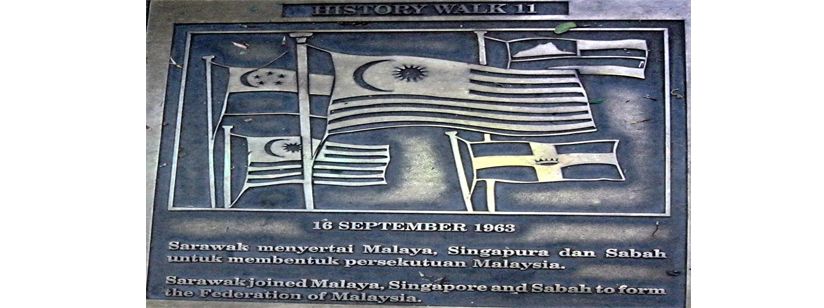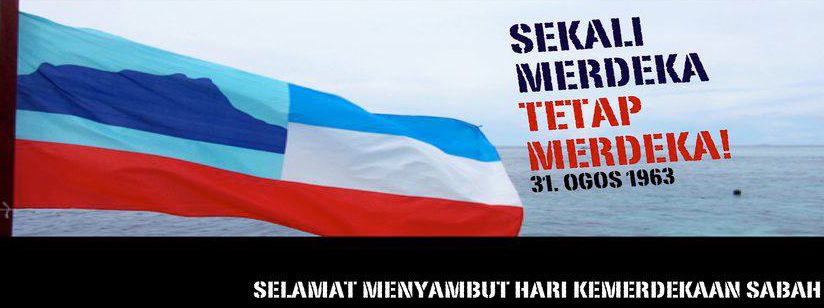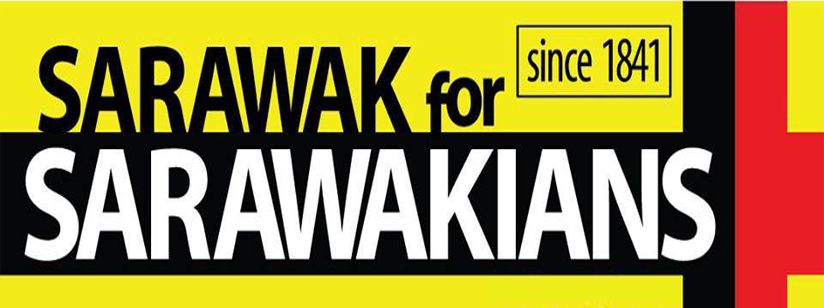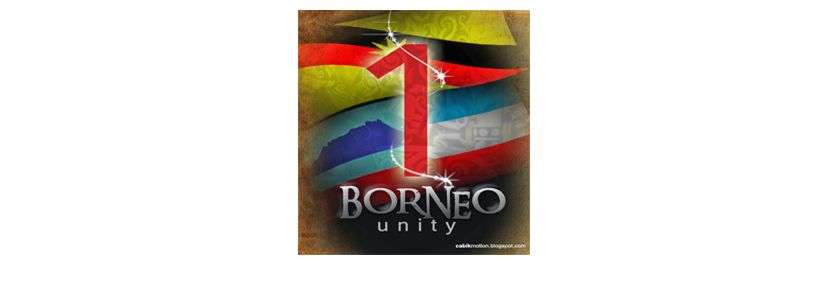Monday, 24 December 2012
Monday, December 24, 2012
Federation of Malaysia 16 September 1963
,
International
,
North Borneo
,
Sarawak
2
comments
Merry X'Mas to all Borneon!
Tuesday, 18 December 2012
Tuesday, December 18, 2012
18 Points
,
20 Points
,
Agreement of Malaysia
,
Sabah
,
Sarawak
,
SSKM
1 comment
SARAWAKIAN & SABAHAN DEMAND FOR OUR RIGHTS
Thursday, 8 November 2012
Letter from Wallace 1855 - in Sarawak, Borneo
Original now in the library of The Natural History Museum (London)
In February 1855 whilst staying in a small house in Sarawak, Borneo, Wallace wrote what was probably the most important paper on evolution prior to the discovery of natural selection. Wallace's "Sarawak Law " paper made such an impression on the famous geologist Charles Lyell that in November 1855, soon after reading it, he started writing his "species notebook" in which he began to contemplate the implications of evolutionary change. In April 1856 Lyell paid a visit to Darwin at Down House, and Darwin explained his theory of natural selection to Lyell for the first time: a theory which Darwin had been working on, more or less in secret, for about 20 years. Soon afterwards Lyell sent a letter to Darwin urging him to publish the theory lest someone beat him to it (he probably had Wallace in mind!) and in May 1856 Darwin heeding this advice, began to write a "sketch" of his ideas for publication. This "sketch" was abandoned in about October 1856 and Darwin instead began to write an extensive book about evolution.
In February 1858 Wallace was suffering from an attack of fever in the village of Dodinga on the remote Indonesian island of Halmahera when suddenly the idea of natural selection as the mechanism of evolutionary change occurred to him. As soon as he had sufficient strength he wrote an detailed essay explaining his theory and sent it together with a covering letter to Charles Darwin, who he knew from correspondence was interested in the subject of evolution. He asked Darwin to pass the essay on to Charles Lyell if Darwin thought it was sufficiently interesting:- no doubt hoping that Lyell would help to ensure that it was published in a good journal. Lyell (who Wallace had never corresponded with) was one of the most respected scientists of the time and Wallace must have thought that he would be interested in reading his new theory because it explained the "laws" which Wallace had proposed in his "Sarawak Law" paper. Darwin had mentioned in a letter to Wallace that Lyell had found Wallace's 1855 paper noteworthy.
Unbeknownst to Wallace, Darwin had of course discovered natural selection many years earlier. He was therefore horrified when he received Wallace's letter and immediately appealed to his influential friends Lyell and Joseph Hooker for advice on what to do. Lyell and Hooker decided to present Wallace's essay (without first asking his permission!), along with two unpublished excerpts from Darwin's writings on the subject, to a meeting of the Linnean Society of London on 1 July 1858. These documents were published together in the Society's journal on 20 August of the same year as the paper "On the Tendency of Species to Form Varieties; And On the Perpetuation of Varieties and Species by Natural Means of Selection". Darwin's contributions were placed before Wallace's essay, thus emphasising Darwin's priority to the idea. Wallace later remarked that the paper "was printed without my knowledge, and of course without any correction of proofs", contradicting Lyell and Hooker's statement in their introduction to the joint papers that "both authors...[have]...unreservedly placed their papers in our hands". This unfortunate event prompted Darwin to abandon writing his big book on evolution and instead produce an "abstract" of what he had written up until that point. This "abstract" was published fifteen months later in November 1859 as his famous book On the Origin of Species.
Wallace's discovery of natural selection occurred almost at the midpoint of his stay in the Malay Archipelago. He was to remain there four more years, and by the end of his trip (and for the rest of his life) he was known as the greatest living authority on the region. He was especially known for his studies on its zoogeography, including his discovery and description of the faunal discontinuity that now bears his name. The "Wallace Line," extends between the islands of Bali and Lombok and Borneo and Sulawesi, and marks the limits of eastern extent of many Asian animal species and, conversely, the limits of western extent of many Australasian animals.
Wallace returned to England in 1862 and in the spring of 1866 he married Annie, the twenty-year-old daughter of his friend the botanist William Mitten. Two of their children, Violet and William, survived to adulthood (a third died in infancy).
Wallace spent the rest of his long life popularising the theory of natural selection and working on a very wide variety of other subjects. He wrote more than 700 articles and 22 books, the best known being The Malay Archipelago, The Geographical Distribution of Animals, and Darwinism. Honours awarded for the many important contributions he made to biology, geography, geology and anthropology include: the Gold Medal (Société de Géographie); the Founder's Medal (Royal Geographical Society); the Darwin-Wallace and Linnean Gold Medals (Linnean Society); the Copley, Darwin and Royal Medals (Royal Society); and the Order of Merit (the greatest honor that can be given to a civilian by the ruling British monarch).
By the turn of the century, Wallace was very probably Britain's best known naturalist and by the end of his life, he may well have been one of the world's most famous people. He remained active into his ninety-first year but slowly weakened in his final months. He died in his sleep at Broadstone on 7 November 1913, and three days later he was buried in a public cemetery nearby. On the 1st November 1915 a medallion bearing his name was placed in Westminster Abbey.
Wednesday, 24 October 2012
How places got their names (North Borneo-Sabah)
The following is collected from the collective memories of NBHE members. It's not much but I thought it would be a waste not to share it.
Api Api was what Kota Kinabalu used to be known before the name was changed to Jesselton and later to Kota Kinabalu. Some Hakka still refer KK as Ya Pi. There are at least 2 accounts on how the settlement came to be known as Api Api. 1) Named after a big fire caused by rebels in 1897 which razed down the Pulau Gaya settlement. 2) named after some kind of plants which were plentiful in KK.
Karamunsing in Kota Kinabalu was named after a type of plant/tree used to be abundant in the area, which in local dialect was known as Karamunceng or Karamunsheng tree.
Keningau used to be known as Kaningau. Oscar Cook in 'Borneo the Stealer of Hearts' mentioned it as such. The town got its name from a type of cinnamon tree known as Kaningau in local dialect which grow/grew abundantly there.
Kota Belud was derived from Sama words, which directly translates to Hill Fort, or rather, Fort on the Hills. It was one of Mat Salleh's strongholds during the 1897-1900 uprising against the (British) Chartered North Borneo Company.
Labuan got it's name from the "Malay" word for anchorage i.e. Labu-an. In Sama language labu' means drop and labu-an is to drop, in this case dropping achor. A Bruneian would have pronounced it as Labu-han. A small village in Kota Belud shares both the name and the role as an achorage, albeit on a small river for small sampans.
Lok Kawi is named after Cowie. Lok is bay in Bajau language and Kawi is the Malaynised Cowie
Manggatal is the correct name not Menggatal, some overzelous outsider coined this Menggatal. The name was derived from a mango tree which found abound near the present river, the type of mango "kambasang" which is quite coarse and it irritates your throat hence gatal in Malay. The place has a lot of these species of mango, hence Manggatal was born.
Sandakan was said to have acquired its name from the word Sanda-kan, where Sanda means pawn off/sell off. This word is common among the peoples living in the area and Southern Philippines, as well as the Iranun people in Kota Belud. Obviously this refers to the British North Borneo Company (later chartered) acquisition/lease of the area from the Sulu Sultanate in the early 1870's.
Tenghilan named after a large Manggilan tree where people used to do their daily sustenance activities
Taun Gusi, a major village in Kota Belud got it's name after a major flood decades ago accidentally unearthed many ancient Chinese jars, similar to the ones that are very popular among many tribes in Sabah. The words Taun Gusi literally translates to Jungle of Jars in Sama language.
Api Api was what Kota Kinabalu used to be known before the name was changed to Jesselton and later to Kota Kinabalu. Some Hakka still refer KK as Ya Pi. There are at least 2 accounts on how the settlement came to be known as Api Api. 1) Named after a big fire caused by rebels in 1897 which razed down the Pulau Gaya settlement. 2) named after some kind of plants which were plentiful in KK.
Karamunsing in Kota Kinabalu was named after a type of plant/tree used to be abundant in the area, which in local dialect was known as Karamunceng or Karamunsheng tree.
Keningau used to be known as Kaningau. Oscar Cook in 'Borneo the Stealer of Hearts' mentioned it as such. The town got its name from a type of cinnamon tree known as Kaningau in local dialect which grow/grew abundantly there.
Kota Belud was derived from Sama words, which directly translates to Hill Fort, or rather, Fort on the Hills. It was one of Mat Salleh's strongholds during the 1897-1900 uprising against the (British) Chartered North Borneo Company.
Labuan got it's name from the "Malay" word for anchorage i.e. Labu-an. In Sama language labu' means drop and labu-an is to drop, in this case dropping achor. A Bruneian would have pronounced it as Labu-han. A small village in Kota Belud shares both the name and the role as an achorage, albeit on a small river for small sampans.
Lok Kawi is named after Cowie. Lok is bay in Bajau language and Kawi is the Malaynised Cowie
Manggatal is the correct name not Menggatal, some overzelous outsider coined this Menggatal. The name was derived from a mango tree which found abound near the present river, the type of mango "kambasang" which is quite coarse and it irritates your throat hence gatal in Malay. The place has a lot of these species of mango, hence Manggatal was born.
Sandakan was said to have acquired its name from the word Sanda-kan, where Sanda means pawn off/sell off. This word is common among the peoples living in the area and Southern Philippines, as well as the Iranun people in Kota Belud. Obviously this refers to the British North Borneo Company (later chartered) acquisition/lease of the area from the Sulu Sultanate in the early 1870's.
Tenghilan named after a large Manggilan tree where people used to do their daily sustenance activities
Taun Gusi, a major village in Kota Belud got it's name after a major flood decades ago accidentally unearthed many ancient Chinese jars, similar to the ones that are very popular among many tribes in Sabah. The words Taun Gusi literally translates to Jungle of Jars in Sama language.
Saturday, 20 October 2012
Saturday, October 20, 2012
18 Points
,
20 Points
,
Agreement of Malaysia
,
Exposing the Truth
1 comment
VIOLATED 18/20 AGREEMENT
Thursday, 27 September 2012
MALAYA, KOREA and BORNEO
ANZAC Square, Brisbane. Brisbane 4000
~~~~~~~~~~~~~~~~~~~~~~~~~
Korea Malaya and Borneo Memorial depicting soldiers in winter and jungle uniforms. The winter uniform signifies the struggle with the extreme weather conditions that faced the
~~~~~~~~~~~~~~~~~~~~~~~~~
Korea Malaya and Borneo Memorial depicting soldiers in winter and jungle uniforms. The winter uniform signifies the struggle with the extreme weather conditions that faced the
Australian troops during 1950-53. The northern winter was a stark contrast the oppressive heat and humidity that the personnel faced during the post-WW2 conflicts in Malaya and the Borneo. The cast bronze figures are fine in their detail and provide a suitable commemoration of those personnel who served and died in these conflicts.
Sunday, 16 September 2012
Sunday, September 16, 2012
18 Points
,
20 Points
,
Agreement of Malaysia
,
Doris Jones
,
Exposing the Truth
,
History
,
Malaysian.
,
North Borneo
,
Sabah
,
Sarawak
,
SSKM
,
Video
No comments
A message to all North Borneo (Sabah) and Sarawak people...
Please watch, listen and understand it... Then, download it and share it to all of your friends (Sabahan and Sarawakian)... Thank you.
Tuesday, 11 September 2012
Tuesday, September 11, 2012
18 Points
,
20 Points
,
Agreement of Malaysia
,
Exposing the Truth
,
Fact
,
History
,
International
,
kongsi cerita
,
Malaysia
,
Malaysian.
,
North Borneo
,
Report
,
Rights
,
Sabah
,
Sarawak
,
Sharing
,
SSKM
1 comment
Sabah ada Hak berpisah dengan Persekutuan!
KOTA KINABALU: Malaysian history professor DS Ranjit has come under fire in Sabah for declaring that the people of the state no longer have the fundamental right to self-determination (click here to read the article) as their legislators had surrendered that power a long time ago.
The Universiti Malaya historian, whose talk entitled “Sabah prospects and retrospect: The aftermath of colonial rule” here on Thursday, put forward the argument that the British colony which had joined Sarawak, Singapore and Malaya to form Malaysia on Sept 16, 1963, would never be able to legally withdraw from the union.
The state’s autonomy champion, maverick politician Jeffrey Kitingan, promptly disputed this fact, saying the argument put forward by Ranjit was guesswork and unsound.
Jeffrey, the chairman of United Borneo Front (UBF), was imprisoned without trial under the infamous Internal Security Act (ISA) in 1991 for allegedly having secessionist views during the rule of Parti Bersatu Sabah (PBS) from 1986 to 1994.
“The major issue, with regard to Sabah’s right to secession, is the fact that the Malaysia Agreement is now viewed by the general opinion to be invalid from the moment Singapore left the federation,” he said.
“This is due to the fact that by normal understanding of law, if a signatory to an agreement withdraws from the agreement, the agreement automatically becomes invalid and no longer in effect.”
Sabah, Sarawak not consulted
Jeffrey reminded Ranjit that when Kuala Lumpur decided on the expulsion of Singapore, it did so unilaterally without consulting Sabah and Sarawak though they were equal partners in the formation of Malaysia.
“While this is another case of a condescending attitude of KL towards the Borneo states, it was also a contravention of the mutual agreement and mutual consultation as established during the signing of the Malaysia Agreement,” he said.
“As to the excuse that Sabah has no right to secede because the State Legislative Assembly passed a resolution that Sabah would not secede, we must remember that the same house could have made the opposite decision.
“The resolution can even be reversed today if enough members of the house agree to do it.”
Replying to Ranjit’s question that “…if the original agreement was null and void after Singapore’s expulsion, then why did the state assembly pass this law?” Jeffrey said that the assembly must have made a resolution not to secede because of pressure from Kuala Lumpur, and there was fear that the agreement was actually null and void.
“If the agreement was still in effect and valid, why the need to pass a law to validate the agreement?” he asked.
Jeffrey, who has repeatedly raised the 20-Point Agreement signed during the formation of Malaysia which granted Sabah a degree of autonomy, reminded Ranjit that Kuala Lumpur had the moral responsibility to consult the people of Sabah before expelling Singapore “because we together formed Malaysia following a referendum conducted by the Cobbold Commission”.
Razak’s decision
Jeffrey said the unilateral decision by then prime minister, Tun Abdul Razak Hussein, had forced him to belatedly and “guiltily make a tour of the two states to explain the departure of Singapore”.
“The people of Sabah and Sarawak can also claim their right to self-determination based on the United Nations Declaration on the Rights of Indigenous Peoples,” he said.
“Anyway, a decision to curtail a people’s right to secede is against the principle of human rights.
“And, keep in mind that Point 7 of the 20 Points is not even a safeguard for Sabahans but a curtailment of their right to self-determination.”
Jeffrey, the younger brother of deputy chief minister Joseph Pairin Kitingan, also said Ranjit’s opinion about the validity of the Malaysia Agreement has yet to be tested in a court of law.
Source: http://www.freemalaysiatoday.com/category/nation/2011/10/22/jeffrey-dismisses-historians-view/
Tuesday, September 11, 2012
18 Points
,
20 Points
,
Agreement of Malaysia
,
Exposing the Truth
,
Fact
,
History
,
Malaysia
,
Malaysian.
,
Memorandum
,
News
,
Sabah
,
Sarawak
,
SSKM
No comments
Ada usaha untuk pisahkan Sarawak?
Perlu di ingatkan kepada semua warga Sarawak... Pembentukkan Malaysia ini adalah hasil daripada persetujuan yang dicapai oleh pemimpin-pemimpin Sabah, Sarawak, Singapura dan Malaya yang bersetuju untuk membentuk sebuah Perikatan yang dinamai Persekutuan Malaysia dengan harapan bahawa negara-negara yang bersekutu ini mendapat manfaatnya daripada aspek pembangunan ekonomi, politik, kesihatan dan bermacam-macam lagi.
Tapi bila dilihat sekarang pula, bukan kemajuan yang dicapai tetapi kemunduran, penindasan, dan ketidakadilan dalam Persekutuan ini. Tambahan lagi, dengan keluarnya Singapura daripada Persekutuan ini, ia secara langsung telah membatalkan perjanjian Malaysia... Adalah menjadi hak rakyat Sarawak sama ada ingin meneruskan untuk bersama dengan Malaya dalam Persekutuan Malaysia ini atau tidak. Itu adalah HAK MUTLAK BANGSA SARAWAK YANG MERDEKA DAN BERDAULAT!
Melalui tinjaun yang dijalankan tahun lepas, lebih kurang 80% rakyat Sarawak TIDAK MAHU BERSAMA DENGAN MALAYA LAGI. Ini membawa maksud, rakyat Sarawak mahu BERPISAH "Unfederated" daripada Persekutuan Malaysia. Maka, rakyat Sarawak, bangkitlah dan berjuanglah untuk bangsa dan Negara anda (Sarawak) untuk masa depan cucu dan cicit anda!
Tuesday, September 11, 2012
18 Points
,
20 Points
,
Agreement of Malaysia
,
Exposing the Truth
,
Fact
,
History
,
Malaysia
,
Malaysian.
,
Memorandum
,
News
,
North Borneo
,
Report
,
Rights
,
Sabah
,
Sarawak
,
Sharing
,
SSKM
No comments
Perbezaan Hari Kemerdekaan Amerika Syarikat dengan Malaysia
Perbezaan 31 Ogos 1957, 16 September 1963 and 4 Julai 1776
Jika USA Federation disamakan dengan Malaysia, adalah sesuatu yang tidak relevan dan bercanggah sama sekali dengan garis masa sejarah atau HISTORY TIMELINE kerana:
1. USA wujud terlebih dahulu dan negeri yang lain “memohon untuk menjadi ahli” USA dan pasti tarikh 4 Julai haruslah dipersetujui sebagai tarikh kumulatif kemerdekaan USA itu sendiri.
2. Malaysia tidak wujud sebelum 16 September tetapi hanya MALAYA, dan Sabah, Sarawak dan Singapura TIDAK MEMOHON untuk menyertai “PERSEKUTUAN MALAYA” tetapi sebaliknya Malaya yang memohon kepada Sabah, Sarawak dan Singapura untuk bersama-sama berganding bahu dan usaha MEMBENTUK MALAYSIA.
3. Jika kita menganggap 16 September sebagai Hari Sabah dan Sarawak menyertai Malaysia, dan kita kena akur bahawa 31 Ogos adalah tarikh KUMULATIF kemerdekaan Malaysia, maka Malaysia itu adalah MALAYA. Jadi, ia telah bertentangan dengan SARANAN COBBOLD bahawa Malaysia BUKAN UNITARI kerana USA bersistemkan FEDERATIONAL UNITARY. Dan secara automatik ia bercanggah dengan PERJANJIAN MALAYSIA bahawa NAMA PERSEKUTUAN ADALAH “MALAYSIA” dan BUKAN “MELAYU RAYA”.






















































